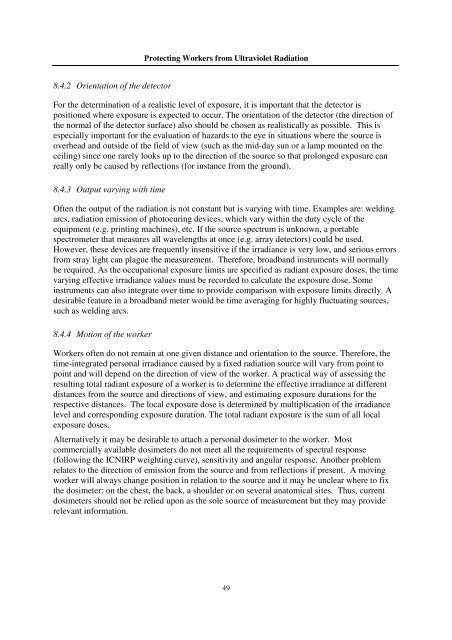Protecting Workers from Ultraviolet Radiation - icnirp
Protecting Workers from Ultraviolet Radiation - icnirp
Protecting Workers from Ultraviolet Radiation - icnirp
Create successful ePaper yourself
Turn your PDF publications into a flip-book with our unique Google optimized e-Paper software.
8.4.2 Orientation of the detector<br />
<strong>Protecting</strong> <strong>Workers</strong> <strong>from</strong> <strong>Ultraviolet</strong> <strong>Radiation</strong><br />
For the determination of a realistic level of exposure, it is important that the detector is<br />
positioned where exposure is expected to occur. The orientation of the detector (the direction of<br />
the normal of the detector surface) also should be chosen as realistically as possible. This is<br />
especially important for the evaluation of hazards to the eye in situations where the source is<br />
overhead and outside of the field of view (such as the mid-day sun or a lamp mounted on the<br />
ceiling) since one rarely looks up to the direction of the source so that prolonged exposure can<br />
really only be caused by reflections (for instance <strong>from</strong> the ground).<br />
8.4.3 Output varying with time<br />
Often the output of the radiation is not constant but is varying with time. Examples are: welding<br />
arcs, radiation emission of photocuring devices, which vary within the duty cycle of the<br />
equipment (e.g. printing machines), etc. If the source spectrum is unknown, a portable<br />
spectrometer that measures all wavelengths at once (e.g. array detectors) could be used.<br />
However, these devices are frequently insensitive if the irradiance is very low, and serious errors<br />
<strong>from</strong> stray light can plague the measurement. Therefore, broadband instruments will normally<br />
be required. As the occupational exposure limits are specified as radiant exposure doses, the time<br />
varying effective irradiance values must be recorded to calculate the exposure dose. Some<br />
instruments can also integrate over time to provide comparison with exposure limits directly. A<br />
desirable feature in a broadband meter would be time averaging for highly fluctuating sources,<br />
such as welding arcs.<br />
8.4.4 Motion of the worker<br />
<strong>Workers</strong> often do not remain at one given distance and orientation to the source. Therefore, the<br />
time-integrated personal irradiance caused by a fixed radiation source will vary <strong>from</strong> point to<br />
point and will depend on the direction of view of the worker. A practical way of assessing the<br />
resulting total radiant exposure of a worker is to determine the effective irradiance at different<br />
distances <strong>from</strong> the source and directions of view, and estimating exposure durations for the<br />
respective distances. The local exposure dose is determined by multiplication of the irradiance<br />
level and corresponding exposure duration. The total radiant exposure is the sum of all local<br />
exposure doses.<br />
Alternatively it may be desirable to attach a personal dosimeter to the worker. Most<br />
commercially available dosimeters do not meet all the requirements of spectral response<br />
(following the ICNIRP weighting curve), sensitivity and angular response. Another problem<br />
relates to the direction of emission <strong>from</strong> the source and <strong>from</strong> reflections if present. A moving<br />
worker will always change position in relation to the source and it may be unclear where to fix<br />
the dosimeter: on the chest, the back, a shoulder or on several anatomical sites. Thus, current<br />
dosimeters should not be relied upon as the sole source of measurement but they may provide<br />
relevant information.<br />
49



